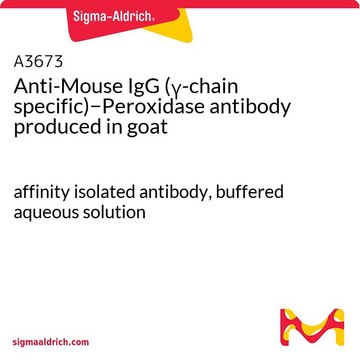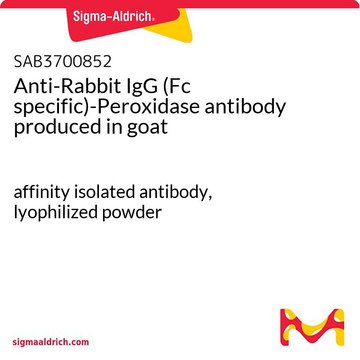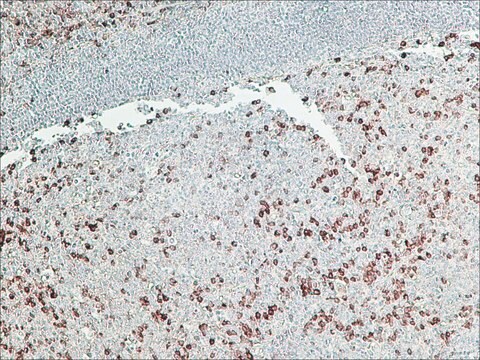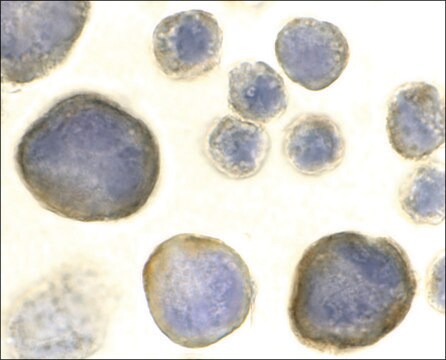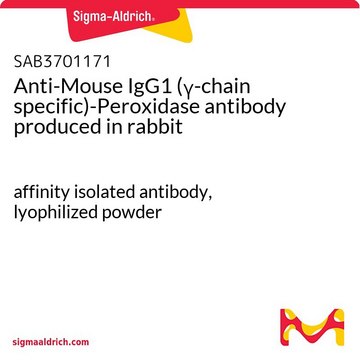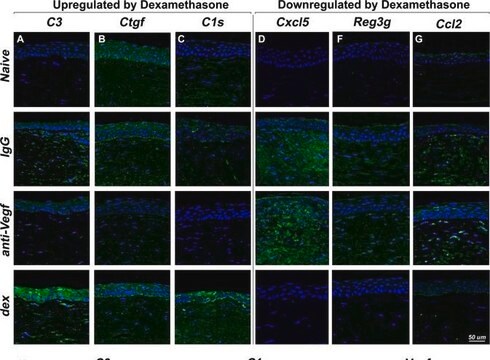SAB3701037
Anti-Mouse IgG (γ-chain specific)-Peroxidase antibody produced in rabbit
affinity isolated antibody, lyophilized powder
Synonym(s):
HRP
Sign Into View Organizational & Contract Pricing
All Photos(1)
About This Item
UNSPSC Code:
12352203
NACRES:
NA.46
Recommended Products
biological source
rabbit
Quality Level
conjugate
peroxidase conjugate
antibody form
affinity isolated antibody
antibody product type
secondary antibodies
clone
polyclonal
form
lyophilized powder
species reactivity
mouse
technique(s)
immunohistochemistry: suitable
indirect ELISA: suitable
western blot: suitable
shipped in
wet ice
storage temp.
2-8°C
target post-translational modification
unmodified
Related Categories
Specificity
This product was prepared from monospecific antiserum by immunoaffinity chromatography using antigens coupled to agarose beads followed by solid phase adsorption(s) to remove any unwanted reactivities. Assay by immunoelectrophoresis resulted in a single precipitin arc against Anti-Peroxidase, Anti-Rabbit Serum, Mouse IgG and Mouse Serum. Specificity was confirmed by ELISA at less than 1% cross-reactivity against other Mouse heavy or light chain isotypes.
Immunogen
Mouse IgG gamma heavy chain
Physical properties
Antibody format: IgG
Physical form
Supplied in 0.02 M Potassium Phosphate, 0.15 M Sodium Chloride, pH 7.2 with 10 mg/mL Bovine Serum Albumin (BSA) - Immunoglobulin and Protease free
Reconstitution
Reconstitute with 1.0 mL deionized water (or equivalent).
Disclaimer
Unless otherwise stated in our catalog or other company documentation accompanying the product(s), our products are intended for research use only and are not to be used for any other purpose, which includes but is not limited to, unauthorized commercial uses, in vitro diagnostic uses, ex vivo or in vivo therapeutic uses or any type of consumption or application to humans or animals.
Not finding the right product?
Try our Product Selector Tool.
Choose from one of the most recent versions:
Certificates of Analysis (COA)
Lot/Batch Number
Don't see the Right Version?
If you require a particular version, you can look up a specific certificate by the Lot or Batch number.
Already Own This Product?
Find documentation for the products that you have recently purchased in the Document Library.
Kinga Csorba et al.
Frontiers in immunology, 10, 2619-2619 (2019-12-04)
Previous infection with Epstein-Barr virus (EBV) is believed to trigger autoimmunity and to drive autoantibody generation as occurring in patients with systemic lupus erythematosus (SLE). Complement C1q and autoantibodies targeting it (anti-C1q) are also considered to be involved in the
Tamer Y Mahmoud et al.
Parasitology research, 113(12), 4513-4523 (2014-10-01)
Despite the wide current use of praziquantel (PZQ) in treatment of schistosomiasis, low cure rates have been recorded in many studies. The aim of this study was directed to evaluate the curative effect of propolis (Pps) alone or in combination
Saar Tal et al.
Virology, 468-470, 631-636 (2014-10-14)
The P4 promoter of the autonomous parvovirus Minute Virus of Mice (MVM) drives the production of its non-structural proteins, NS1 and NS2. The NS2 isoforms are without enzymatic activity but interact with cellular proteins. While NS2 is crucial to the
C S Pinheiro et al.
Parasite immunology, 36(7), 303-312 (2014-04-23)
Schistosoma mansoni is a blood fluke parasite responsible for schistosomiasis. The best long-term strategy to control schistosomiasis is through immunization combined with drug treatment. In this study, we cloned, expressed and purified SmTSP-2 fused to the N- and C-terminal halves
Ranadhir Dey et al.
Journal of immunology (Baltimore, Md. : 1950), 193(7), 3513-3527 (2014-08-27)
Previously, we showed that genetically modified live-attenuated Leishmania donovani parasite cell lines (LdCen(-/-) and Ldp27(-/-)) induce a strong cellular immunity and provide protection against visceral leishmaniasis in mice. In this study, we explored the mechanism of cross-protection against cutaneous lesion-causing
Global Trade Item Number
| SKU | GTIN |
|---|---|
| SAB3701037-1MG | 4061838356376 |
Our team of scientists has experience in all areas of research including Life Science, Material Science, Chemical Synthesis, Chromatography, Analytical and many others.
Contact Technical Service